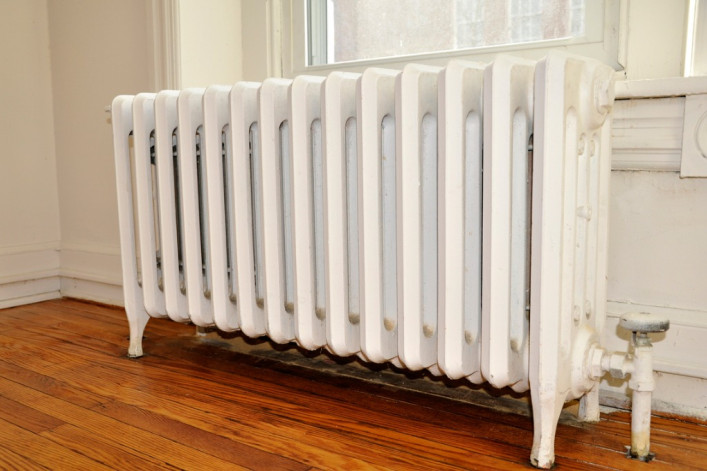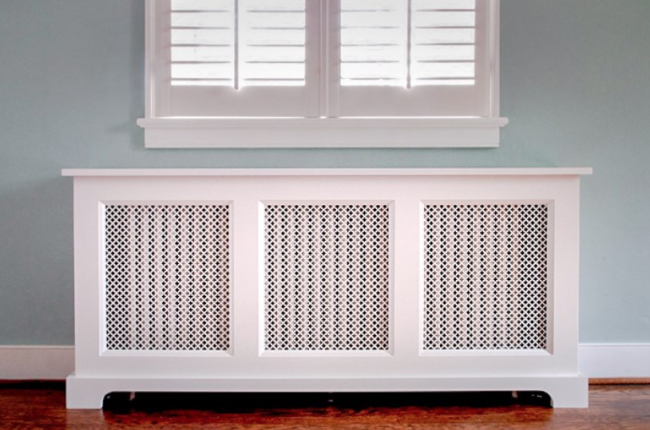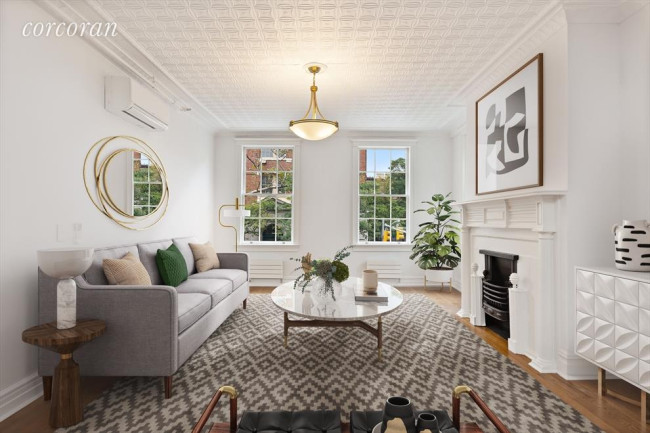6 things you really need to know about your NYC radiators
- Cast-iron radiators give off heat generated by boilers in your building's basement
- Radiators make some noise when the heat kicks in, but excessive noise requires a fix

See the circular knob near the floor? It doesn't regulate temperature, it is just a big on-off switch.
iStock
If you live in an older New York City building, you’re probably already familiar with the random hissing and clunking sounds of your old-fashioned radiator. Not only are these radiators noisy, but they can get very hot, or worse, not heat up at all.
Most NYC buildings are steam-heated, relying on water warmed by a boiler in the basement and distributed via sturdy, cast iron radiators. If you have a thermostat installed, you can regulate the temperature yourself. If not, your landlord or building management is supposed to abide by NYC's minimum heat requirements after Oct. 1st, when the temperature drops below 55 outside during the day.
That means the indoor temperature must be at least 68 degrees during the day, from 6 a.m. to 10 p.m. At night, the temperature inside your apartment must be at least 62 degrees, no matter the temperature outside.
Don't have heat or your place just isn't warm enough? Here's how to get your management company or landlord to comply with the rules. Read on for Brick Underground’s cheat sheet on everything from installing a thermostatic valve to making your radiator more attractive and functional.
[Editor's note: An earlier version of this article was published in October 2021. We are presenting it again in case you missed it.]
1. How to use the knob to turn your radiator on or off
A lot of people mistakenly believe that the circular knob on a steam radiator regulates the temperature, when it’s actually just an on-off switch, said Peter Varsalona, principal and vice president of RAND Engineering & Architecture. "It's not designed to be a control valve.”
Typically, you can turn the knob clockwise to turn the heat off, and counter-clockwise all the way to turn the heat on. If the radiator is off, it shouldn't make any banging sounds.
"When you have it opened halfway, that can lead to banging problems," Varsalona said. Improperly pitched piping or hot steam hitting cold water can also cause loud noises.
If your radiator knob spins and spins and doesn't seem to tighten in either direction, get your super to fix it. You can also try propping up one side of the radiator so it slopes toward the boiler and water doesn't become trapped. Regardless, you should expect some clanging when the heat gets going in the morning.
2. Installing a valve will let you control the heat
Hot water supply systems have a much broader temperature range than most low pressure steam systems, said Zaid Matalka, an engineer at P.A. Collins PE. Steam systems generally operate at 212 Fahrenheit, or 100 Celsius.
“Ultimately the lack of control in these steam heat systems is why hot water systems are a lot more popular nowadays,” he said.
If you want to regulate the amount of heat your radiator generates in a steam system, you'll have to install a thermostatic radiator valve on each radiator to do it.
There are two different kinds of steam radiator systems, one pipe and two pipe. You can determine which type you have by looking under your radiator to see how many pipes are coming out of the floor. The type you have will dictate what valve to install plus any additional equipment you might need to regulate the heat.
In an effort to modernize these late 19th- and early 20th-century relics, some companies are developing wifi-enabled thermal radiator covers that let users regulate the heat through an app.
Unfortunately, even if your radiators are off, many apartments on higher floors get very hot on particularly warm days because steam is giving off heat from the pipes that connect the radiators to the boiler. (More on that below.)
3. You may need to bleed the radiator if it is noisy or cold
If your heat is on but a radiator remains ice cold, it's possible air is trapped inside and isn’t allowing hot water to circulate. Excessive noise, like a banging sound, is a sign you may need to bleed the unit. (Only hot water radiators need to bleed, not steam radiators.)
This isn’t typically something you want to do yourself—at least not the first time. If you're not careful, you can open the valve too wide and boiling hot water can come gushing out.
Get in touch with your super and tell them you have a problem with your heating unit. If bleeding the radiator is indeed the solution, ask if you can watch the process to learn how to do it safely.
4. Where to buy radiator covers
If your radiator looks like it could use some prettying up, you can either paint it or put a cover on to hide it. Some companies even offer custom-design covers. (And no, your landlord is not required to pay for your radiator covers.)
It’s also possible to strip and paint both radiators and radiator covers. For smaller jobs, covers can be sanded, scraped, have their blemishes filled in, and then painted. Chemical stripping and painting is a bigger job and costs more.
Depending on how many radiators you have in your apartment, repainting them should take one or two days. You'll also have to turn off your radiator if the job requires stripping. If you want a more basic restoration job, you can just have radiators scraped and sanded to smooth out the blemishes.
5. What to know about replacing old radiators
It's not uncommon for co-op owners to replace their large, cast-iron radiators with smaller, stylish ones, Varsalona said. Just keep in mind that radiator and radiator piping can be considered "common elements," so you may need to get board approval to replace them.
If you're choosing to remove your radiators altogether, make sure you keep them somewhere safe so that you can reinstall them when you're ready to sell your apartment.
And a note of caution: If you've recently replaced your radiators during a renovation (or are renting a new apartment and haven't used your radiators before), it's always a good idea to turn them on and make sure there are no leaks while your contractor or super is still around and can help fix a problem.
If there is a leak it usually means something's wrong with the pipe connection, a problem that can be pretty easily repaired by a super, but could cause a lot of destruction to your apartment and the one below it if left unaddressed.
6. What to do when your apartment is too hot in winter
If your apartment is too hot, even with the radiators off, you may have to come up with some creative solutions. One suggestion is to put inexpensive fiberglass pipe covers around your pipes. This keeps the heat from pipes in the apartment adding to the temperature.
Matalka suggests getting in touch with the building manager or super and requesting the heat be lowered. There might be others in the building who feel the same way.
Opening a window and getting a good mix of cold fresh air in the room is another time-tested option. The downside, Matalka said, is that it isn't great for the environment. “You're throwing away heat that was generated by burning fossil fuel, which in turn releases greenhouse gasses into the atmosphere,” he said. (That’s certainly not going to help with your building’s Local Law 97 emissions goals.)
If you’re getting dry skin as a result of the heat, humidifiers can be an effective remedy. Warm mist and cool mist humidifiers do the same thing but keep in mind—pets and small children can get hurt by warm mist machines.
—Earlier versions of this article contained reporting and writing by Lucy Cohen Blatter and Georgia Kral. It was updated in 2024 by Celia Young.




























